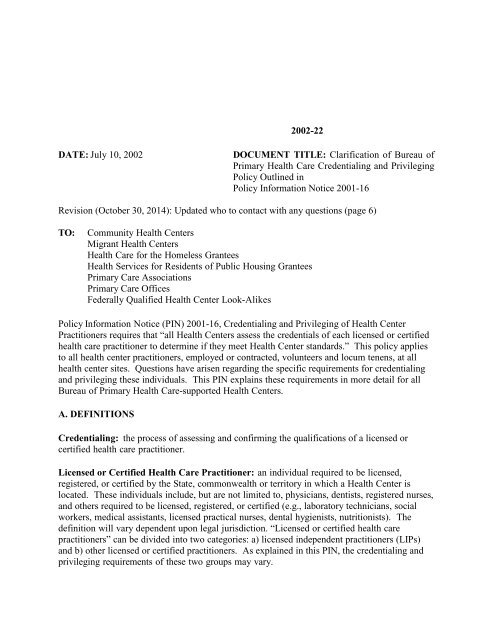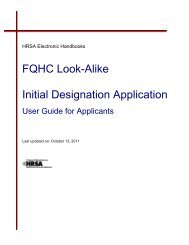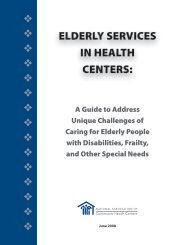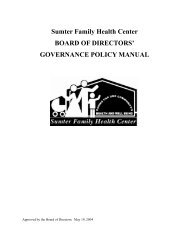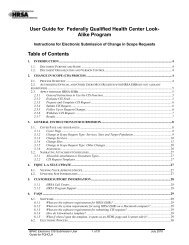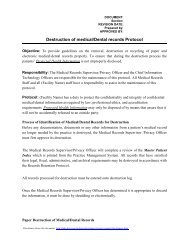PIN 2002-22 - Bureau of Primary Health Care - HRSA
PIN 2002-22 - Bureau of Primary Health Care - HRSA
PIN 2002-22 - Bureau of Primary Health Care - HRSA
You also want an ePaper? Increase the reach of your titles
YUMPU automatically turns print PDFs into web optimized ePapers that Google loves.
<strong>2002</strong>-<strong>22</strong>DATE: July 10, <strong>2002</strong>DOCUMENT TITLE: Clarification <strong>of</strong> <strong>Bureau</strong> <strong>of</strong><strong>Primary</strong> <strong>Health</strong> <strong>Care</strong> Credentialing and PrivilegingPolicy Outlined inPolicy Information Notice 2001-16Revision (October 30, 2014): Updated who to contact with any questions (page 6)TO:Community <strong>Health</strong> CentersMigrant <strong>Health</strong> Centers<strong>Health</strong> <strong>Care</strong> for the Homeless Grantees<strong>Health</strong> Services for Residents <strong>of</strong> Public Housing Grantees<strong>Primary</strong> <strong>Care</strong> Associations<strong>Primary</strong> <strong>Care</strong> OfficesFederally Qualified <strong>Health</strong> Center Look-AlikesPolicy Information Notice (<strong>PIN</strong>) 2001-16, Credentialing and Privileging <strong>of</strong> <strong>Health</strong> CenterPractitioners requires that “all <strong>Health</strong> Centers assess the credentials <strong>of</strong> each licensed or certifiedhealth care practitioner to determine if they meet <strong>Health</strong> Center standards.” This policy appliesto all health center practitioners, employed or contracted, volunteers and locum tenens, at allhealth center sites. Questions have arisen regarding the specific requirements for credentialingand privileging these individuals. This <strong>PIN</strong> explains these requirements in more detail for all<strong>Bureau</strong> <strong>of</strong> <strong>Primary</strong> <strong>Health</strong> <strong>Care</strong>-supported <strong>Health</strong> Centers.A. DEFINITIONSCredentialing: the process <strong>of</strong> assessing and confirming the qualifications <strong>of</strong> a licensed orcertified health care practitioner.Licensed or Certified <strong>Health</strong> <strong>Care</strong> Practitioner: an individual required to be licensed,registered, or certified by the State, commonwealth or territory in which a <strong>Health</strong> Center islocated. These individuals include, but are not limited to, physicians, dentists, registered nurses,and others required to be licensed, registered, or certified (e.g., laboratory technicians, socialworkers, medical assistants, licensed practical nurses, dental hygienists, nutritionists). Thedefinition will vary dependent upon legal jurisdiction. “Licensed or certified health carepractitioners” can be divided into two categories: a) licensed independent practitioners (LIPs)and b) other licensed or certified practitioners. As explained in this <strong>PIN</strong>, the credentialing andprivileging requirements <strong>of</strong> these two groups may vary.
BPHC Policy Information Notice <strong>2002</strong>-<strong>22</strong>Licensed Independent Practitioner: physician, dentist, nurse practitioner, and nurse midwifeor any other “individual permitted by law and the organization to provide care and serviceswithout direction or supervision, within the scope <strong>of</strong> the individual’s license and consistent withindividually granted clinical privileges” (from Joint Commission on Accreditation <strong>of</strong> <strong>Health</strong>careOrganizations’(JCAHO) <strong>2002</strong>-2003 Comprehensive Accreditation Manual for Ambulatory<strong>Care</strong>). It is the <strong>Health</strong> Center that should determine which individuals (including staff that maynot be covered under Federal Tort Claims Act such as volunteers, certain part-time contractors,medical residents, and locum tenens) meet this definition based on law and the organization’spolicy.Other Licensed or Certified <strong>Health</strong> <strong>Care</strong> Practitioner: An individual who is licensed,registered, or certified but is not permitted by law to provide patient care services withoutdirection or supervision. Examples include, but are not limited to, laboratory technicians, socialworkers, medical assistants, licensed practical nurses, dental hygienists.<strong>Primary</strong> Source Verification: Verification by the original source <strong>of</strong> a specific credential todetermine the accuracy <strong>of</strong> a qualification reported by an individual health care practitioner.Examples <strong>of</strong> primary source verification include, but are not limited to, direct correspondence,telephone verification, internet verification, and reports from credentials verificationorganizations. The Education Commission for Foreign Medical Graduates (ECFMG ® ), theAmerican Board <strong>of</strong> Medical Specialties, the American Osteopathic Association PhysicianDatabase, or the American Medical Association (AMA) Masterfile can be used to verifyeducation and training. The use <strong>of</strong> credentials verification organizations (CVOs) or hospitalsthat meet JCAHO’s “Principles for CVOs” (see Appendix A) is also an acceptable method <strong>of</strong>primary source verification.Secondary Source Verification: Methods <strong>of</strong> verifying a credential that are not considered anacceptable form <strong>of</strong> primary source verification. These methods may be used when primarysource verification is not required. Examples <strong>of</strong> secondary source verification methods include,but are not limited to, the original credential, notarized copy <strong>of</strong> the credential, a copy <strong>of</strong> thecredential (when the copy is made from an original by approved <strong>Health</strong> Center staff).Privileging/Competency: The process <strong>of</strong> authorizing a licensed or certified health carepractitioner’s specific scope and content <strong>of</strong> patient care services. This is performed inconjunction with an evaluation <strong>of</strong> an individual’s clinical qualifications and/or performance.B. CREDENTIALING REQUIREMENTS1. Credentialing <strong>of</strong> LIPs requires primary source verification <strong>of</strong> the following:• Current licensure;• Relevant education, training, or experience;• Current competence; and• <strong>Health</strong> fitness, or the ability to perform the requested privileges, can be determined by astatement from the individual that is confirmed either by the director <strong>of</strong> a trainingprogram, chief <strong>of</strong> staff/services at a hospital where privileges exist, or a licensedphysician designated by the organization.2
BPHC Policy Information Notice <strong>2002</strong>-<strong>22</strong>Credentialing <strong>of</strong> LIPs also requires secondary source verification <strong>of</strong> the following:• Government issued picture identification;• Drug Enforcement Administration registration (as applicable);• Hospital admitting privileges (as applicable);• Immunization and PPD status; and• Life support training (as applicable).The <strong>Health</strong> Center should also query the National Practitioner Data Bank (NPDB) (as applicable)for these LIPs. If the health center is ineligible to query, they should have the LIP provide theresults <strong>of</strong> a self-query <strong>of</strong> the NPDB.The determination that a LIP meets the credentialing requirements should be stated in writing bythe <strong>Health</strong> Center’s governing board (or alternative mechanism as described in a governingboard approved waiver). Ultimate approval authority is vested in the governing board whichmay review recommendations from either the Clinical Director or a joint recommendation <strong>of</strong> themedical staff (including the clinical director) and the Chief Executive Officer. Alternatively, thegoverning board may delegate this responsibility (via resolution or bylaws) to an appropriateindividual to be implemented based on approved policies and procedures (including methods toassess compliance with these policies and procedures).2. Credentialing <strong>of</strong> other licensed or certified health care practitioners requires primary sourceverification <strong>of</strong> the individual’s license, registration, or certification only. Education andtraining may be verified by secondary source verification methods. Verification <strong>of</strong> currentcompetence is accomplished through a thorough review <strong>of</strong> clinical qualifications andperformance.Credentialing <strong>of</strong> other licensed or certified health care practitioners also requires secondarysource verification <strong>of</strong> the following:• Government issued picture identification;• Immunization and PPD status;• Drug Enforcement Administration registration (as applicable),• Hospital admitting privileges (as applicable), and• Life support training (as applicable).Please Note: These requirements are a minimum and do not prevent the <strong>Health</strong> Center fromcredentialing these individuals similarly to LIPs.Credentialing <strong>of</strong> other licensed or certified health care practitioners should be completed prior tothe individual being allowed to provide patient care services.C. PRIVILEGING REQUIREMENTSPolicy Information Notice 2001-16 requires privileging <strong>of</strong> each licensed or certified health carepractitioner specific to the services being provided at each <strong>of</strong> the <strong>Health</strong> Center’s care deliverysettings.3
BPHC Policy Information Notice <strong>2002</strong>-<strong>22</strong>1. The initial granting <strong>of</strong> privileges to LIPs is performed by the health center (see <strong>PIN</strong> 2001-16for specifics) with ultimate approval authority vested in the governing board which mayreview recommendations from either the clinical director or a joint recommendation <strong>of</strong> themedical staff (including the Clinical Director) and the Chief Executive Officer.Alternatively, the governing board may delegate this responsibility (via resolution orbylaws) to an appropriate individual to be implemented based on approved policies andprocedures (including methods to assess compliance with these policies and procedures).2. For other licensed or certified health care practitioners, privileging is completed during theorientation process via a supervisory evaluation based on the job description.3. Temporary privileges may be granted if the <strong>Health</strong> Center follows guidelines specified byJCAHO (see Appendix B).D. PRIVILEGING REVISION OR RENEWAL REQUIREMENTS1. The revision or renewal <strong>of</strong> a LIP’s privileges should occur at least every 2 years and shouldinclude primary source verification <strong>of</strong> expiring or expired credentials, a synopsis <strong>of</strong> peerreview results for the 2 year period and/or any relevant performance improvementinformation. Similar to the initial granting <strong>of</strong> privileges, approval <strong>of</strong> subsequent privileges isvested in the governing board which may review recommendations from either the clinicaldirector, or a joint recommendation <strong>of</strong> the medical staff (including the Clinical Director) andthe Chief Executive Officer, or delegate this responsibility (via resolution or bylawslanguage) to be implemented according to approved policies and procedures (includingmethods to assess compliance with these policies and procedures).2. The revision or renewal <strong>of</strong> privileges <strong>of</strong> other licensed or certified health care practitionersshould occur at a minimum <strong>of</strong> every 2 years. Verification is by supervisory evaluation <strong>of</strong>performance that assures that the individual is competent to perform the duties described inthe job description.3. The health center should have an appeal process for LIP’s if a decision is made todiscontinue or deny clinical privileges. An appeal process is optional for other licensed orcertified health care practitioners.The following table summarizes the credentialing and privileging requirements <strong>of</strong> both categories<strong>of</strong> “licensed or certified health care practitioners,” Licensed Independent Practitioners, and otherlicensed or certified health care practitioners.NOTE: The requirements specified in this <strong>PIN</strong> are not identical to accreditation-relatedstandards pertaining to credentialing and privileging. Therefore, <strong>Health</strong> Centers that areaccredited or seeking accreditation should also review the applicable credentialing andprivileging standards to insure appropriate compliance.4
BPHC Policy Information Notice <strong>2002</strong>-<strong>22</strong>TABLE:COMPARATIVE SUMMARY OF REQUIREMENTS FORCREDENTIALING AND PRIVILEGING “LICENSED ORCERTIFIED HEALTH CARE PRACTIONERS”CREDENTIALING ORPRIVILEGINGACTIVITY“LICENSED OR CERTIFIED HEALTHCARE PRACTITIONER ”LicensedIndependentPractitioner(LIP)Other licensed orcertified practitionerExamples <strong>of</strong> Staff Physician, Dentist RN, LPN, CMA,RegisteredDieticianA. CREDENTIALING METHOD1. Verification <strong>of</strong> licensure, <strong>Primary</strong> source <strong>Primary</strong> Sourceregistration, or certification2. Verification <strong>of</strong> education <strong>Primary</strong> source Secondary source3. Verification <strong>of</strong> training <strong>Primary</strong> source Secondary source4. Verification <strong>of</strong> currentcompetence5. <strong>Health</strong> fitness(Ability to perform the requestedprivileges)<strong>Primary</strong> source,writtenConfirmedstatement6. Approval authority GoverningBody (usuallyconcurrent withprivileging)6. National Practitioner Required, ifData Bank Queryreportable7. Government issued Secondary sourcepicture identification,immunization and PPDstatus, and life supporttraining (if applicable)8. Drug EnforcementAdministration (DEA)registration, hospitaladmitting privilegesSecondary source,if applicableSupervisory evaluationper job descriptionSupervisory evaluationper job descriptionSupervisory functionper job descriptionRequired, if reportableSecondary sourceSecondary source ifapplicable5
BPHC Policy Information Notice <strong>2002</strong>-<strong>22</strong>CREDENTIALING ORPRIVILEGINGACTIVITYB. INITIAL GRANTINGOF PRIVILEGES“LICENSED OR CERTIFIEDHEALTH CARE PRACTITIONER”LicensedIndependentPractitioner(LIP)METHODOther licensed orcertifiedpractitioner1. Verification <strong>of</strong> currentcompetence to provideservices specific to each <strong>of</strong>the organization’s caredelivery settings<strong>Primary</strong> source,based on peerreview and/orperformanceimprovement data.2. Approval authority Governing Body(usually concurrentwith credentialing)Supervisoryevaluation per jobdescriptionSupervisoryevaluation per jobdescriptionC. RENEWAL ORMETHODREVISION OFPRIVILEGES1. Frequency At least every 2 yrs At least every 2yrs2. Verification <strong>of</strong> currentlicensure, registration, orcertification<strong>Primary</strong> source <strong>Primary</strong> source3. Verification <strong>of</strong> currentcompetence<strong>Primary</strong> sourcebased on peerreview and/orperformanceimprovement data.Supervisoryevaluation per jobdescription4. Approval authority Governing Body Supervisoryfunction per jobdescription5. Appeal to discontinueappointment or denyclinical privilegesProcess requiredOrganizationoptionIf you have any questions, please contact the BPHC Help Line at 1-877-974-BPHC orbphchelpline@hrsa.gov .AttachmentsWilliam D. HobsonActing Director, <strong>Bureau</strong> <strong>of</strong> <strong>Primary</strong> <strong>Health</strong> <strong>Care</strong>6
BPHC Policy Information Notice <strong>2002</strong>-<strong>22</strong>APPENDIX AJoint Commission on Accreditation <strong>of</strong> <strong>Health</strong>care OrganizationsPrinciples for CVOs<strong>2002</strong>-2003 Comprehensive Accreditation Manual for Ambulatory <strong>Care</strong> (p. HR-11)“Any organization may use the services <strong>of</strong> a credentials verification organization (CVO). Whileusing such agencies may relieve the organization from the process <strong>of</strong> gathering the information,it does not relieve the organization from the responsibility <strong>of</strong> having complete and accurateinformation. An organization that bases its decisions in part on information obtained from aCVO should achieve a level <strong>of</strong> confidence in the information provided by the CVO, byevaluating the following:• The CVO makes known to the user what data and information it can provide.• The CVO provides documentation to the user describing how its data collection,information development and verification process(es) are performed.• The user is provided with sufficient, clear information on database functions that includes anylimitations <strong>of</strong> information available from the CVO (for example, practitioners not included inthe database), the time frame for CVO responses to requests for information; and a summaryoverview <strong>of</strong> quality control processes related to data integrity, security, transmission accuracy,and technical specifications.• The user and CVO agree on the format for the transmission <strong>of</strong> credentials information aboutan individual from the CVO.• The user can easily discern which information, transmitted by the CVO, is from aprimary source and what is not.• For information transmitted by the CVO that can go out <strong>of</strong> date (for example, licensure, boardcertification), the date the information was last updated from the primary source is provided bythe CVO.• The CVO certifies the information transmitted to the user accurately presents theinformation obtained by it.• The user can discern whether the information transmitted by the CVO from a primary source isall the primary source information in the CVO's possession pertinent to a given item or, if not,where additional information can be obtained.• The user can engage the quality control processes <strong>of</strong> the CVO when necessary to resolveconcerns about transmission errors, inconsistencies, or other data issues that may be identifiedfrom time to time.”7
BPHC Policy Information Notice <strong>2002</strong>-<strong>22</strong>APPENDIX BJoint Commission on Accreditation <strong>of</strong> <strong>Health</strong>care OrganizationsGUIDELINES FOR ISSUING TEMPORARY PRIVILEGES(Based 3/15/02 Standards Clarification: Use <strong>of</strong> Temporary Privileges – CAMAC StandardHR.7.2)The Joint Commission has reviewed its position on the use <strong>of</strong> temporary privileges and hasdetermined that there are two circumstances for which the granting <strong>of</strong> temporary privilegeswould be acceptable:• to fulfill an important patient care need• when an applicant with a complete, clean application is awaitingreview and approval <strong>of</strong> the medical staff executive committeeand the governing bodyIn the first circumstance temporary privileges can be granted on a case by case basis when there is animportant patient care need that mandates an immediate authorization to practice, for a limited period<strong>of</strong> time, while the full credentials information is verified and approved. Examples would include, butare not limited to:• a situation where a physician becomes ill or takes a leave <strong>of</strong> absence and an LIP wouldneed to cover his/her practice until he/she returns (locum tenens)• a specific LIP has the necessary skills to provide care to a patient that an LIP currentlyprivileged does not possessIn these circumstances, temporary privileges may be granted by the CEO upon recommendation <strong>of</strong>either the applicable clinical department chairperson or the president <strong>of</strong> the medical staff providedthere is verification <strong>of</strong>:• current licensure• current competenceIn the second circumstance temporary privileges may be granted when the new applicant for medicalstaff membership or privileges is waiting for a review and recommendation by the medical staffexecutive committee and approval by the governing body. Temporary privileges may be granted fora limited period <strong>of</strong> time, not to exceed 120 days, by the CEO upon recommendation <strong>of</strong> either theapplicable clinical department chairperson or the president <strong>of</strong> the medical staff provided:• there is verification <strong>of</strong>- current licensure- relevant training or experience- current competence- ability to perform the privileges requested- other criteria required by medical staff bylaws8
BPHC Policy Information Notice <strong>2002</strong>-<strong>22</strong>• the results <strong>of</strong> the National Practitioner Data Bank query have been obtained and evaluated• the applicant has:- a complete application- no current or previously successful challenge to licensure or registration- not been subject to involuntary termination <strong>of</strong> medical staff membership at anotherorganization- not been subject to involuntary limitation, reduction, denial, or loss <strong>of</strong> clinical privilegesTemporary privileges are not to be routinely used for other administrative purpose suchas the following situations:• the LIP fails to provide all information necessary to the processing <strong>of</strong> his/her reappointment ina timely manner• failure <strong>of</strong> the staff to verify performance data and information in a timely mannerIn the above situations, the LIP would be required to cease providing care in the facilityuntil the reappointment process is completed.9


